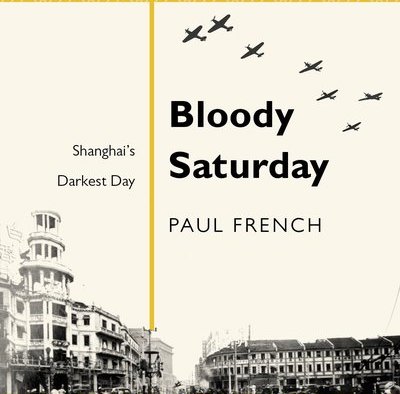|
by Matt Turner
Paul French, Bloody Saturday: Shanghai’s Darkest Day, Penguin, 2017. 116 pgs. 
Most general summaries of Shanghai are too rosy: Shanghai’s famous for its fashion and haute cuisine. It boasts genuinely modern, urban architecture. It’s one of China’s most significant trading ports, and has been since the 18th century. Throughout its history, non-Chinese have called Shanghai their home. Spend time in Shanghai and you’ll love its cosmopolitanism. So it’s instructive to remember that its current “cosmopolitanism” is of a different kind than that which existed prior to the 1949 Communist Revolution. The infamous bordello atmosphere of yesteryear has morphed into a shopping mall; street hawkers have largely been replaced by legitimate, tax-paying businesses and vertical towers have replaced many parts of the otherwise anarchic city. It’s cleaner now, too. Nationalisation of labour and the economy, political centralisation and anti-Western sentiment have all shaped these changes—never mind the massive influx of foreign capital, channelled by the Chinese state into particular sectors from the 1980s on, which followed the liberalisation of the Chinese economy. Another reason for the changes precedes the revolution. In Bloody Saturday: Shanghai’s Darkest Day, Paul French revisits the 1937 Japanese bombardment, and interregnum accidental bombing by the Chinese themselves, of Shanghai during Japan’s invasion of China, as Japan sought to extend its empire and its Greater East-Asian Co-Prosperity Sphere. The immediate effect of these events was to turn Shanghai from a cosmopolitan centre into “a dark, frightened city of refugees.” Out of that dark city Shanghai reasserted itself, becoming what it is today. French begins his book by describing the events that led up to the bombing and the bombing itself. On Monday, August 9th, two Japanese soldiers are shot and killed in a confrontation with the Chinese Peace Preservation Corps. On Wednesday, in response, the Japanese third fleet anchors at Shanghai. On Thursday, two of its ships begin shelling the mostly Chinese, non-international neighbourhoods in the northern part of the city. On Saturday, the Chinese Air Force sends planes to attack the Japanese fleet. For reasons which are never satisfactorily explained by any party, their bombs miss their mark and hit the bustling international settlements, killing hundreds, wounding thousands and uprooting the lives of many more—not to mention significantly damaging property and infrastructure. Foreign embassies urge foreigners to evacuate. The remainder of the book deals with the effects of the bombing, which were significant. As French states, “The combined bombs on Nanking Road and the Great World on Bloody Saturday were the most devastating aerial attacks on a civilian city to that date in history and registered the highest casualty toll yet on record.” Later he goes on: Of the more immediate concern was the need to clear the dead from the devastated portions of the Settlement and Frenchtown. It was to be a long and gruesome job, hampered by continual fighting and shelling to the north and the threat of more accidental bomb drops to the south, as well as petrol and manpower shortages. Some bodies, presumably Chinese, were to remain uncollected for several more days, left to decompose on the streets. A similar scene was painted by the United Press correspondent, John Morris at the time: “I could see at least fifty persons writhing on the sidewalks and roadway. Three foreigners were trying to crawl away over the bodies of the dead Chinese.” It would be too easy to extrapolate that the bombing created a literal tabula rasafrom which the Chinese Communist Revolution quickly grew, i.e. that the devastation of resources allowed for a critical mass of progressive workers and intellectuals to come together and effectively organize. It would also be too easy to extrapolate that because Shanghai was the cosmopolitan centre of China, that many of its critics are correct: it’s not really Chinese, it’s a city made for Westerners. That French’s book centres on the lives of foreigners in wartime Shanghai also demonstrates that for many, Chinese people barely lived there—until 1949, when they decided to claim it as their own. All of those extrapolations and conclusions are incorrect. Shanghai is a Chinese city with a significant international population. The Communists had already been routed out of Shanghai by the Nationalist Party’s (KMT’s) white terror of 1927. What has changed between then and now is that the voices of non-Chinese are no longer broadcast quite so loudly. The settlement neighbourhoods—the “concessions”— are no longer international properties; instead, all of Shanghai is owned by a single power. Shanghai’s domestic critics would do well to look to Zhongnanhai’s capital outflow, as China’s erstwhile defenders—Communist cadres—buy overseas properties, claiming cultural Chineseness while purchasing foreign rights through private property. Which isn’t rosy at all. The changes that Shanghai has been through predate the Communist victory, as well as the recent economic development of China, and “Bloody Saturday,” as tragic as it was, was only one more episode in the fluctuating history of a city that “changes faster, alas, than the human heart.” Without downplaying the significance of the bombing of Shanghai, it is only more consequential than other events in its effects on individuals—of which the book gives many examples. |